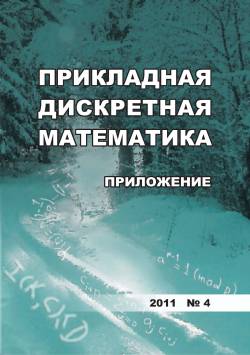Solving undetermined systems of linear boolean equations with corrupted right-hand side and low-weight true solution
Undetermined systems of random linear Boolean equations with corrupted right-hand side and with a true solution of little Hamming weight are studied. Experimentally, we show that, for small bit-error rates, these systems can be efficiently solved by decoding algorithms with regard to information symbols.
Download file
Counter downloads: 122
Keywords
случайные системы линейных булевых уравнений, декодирование по информационным множествам, random systems of linear Boolean equations, information-set decodingAuthors
| Name | Organization | |
| Rumenko N. Yu. | Moscow Technical University of Communications and Informatics | nrum90@yandex.ru |
| Kostyuk A. V. | Moscow Technical University of Communications and Informatics | av_kost@mail.ru |
References
Балакин Г. В. Введение в теорию случайных систем уравнений // Труды по дискретной математике. М.: ТВП, 1997. T. 1. C. 1-18.
Алексейчук А. Н., Грязнухин А. Ю. Быстрый алгоритм восстановления истинного решения фиксированного веса системы линейных булевых уравнений с искажённой правой частью // Прикладная дискретная математика. 2013. Т. 20. №2. С. 59-70.
Варшамов Р. Р. Оценка числа сигналов в кодах с коррекцией ошибок // Доклады АН СССР. 1957. C. 739-741.
May A, Meurer A., and ThomaeE. Decoding random linear codes in O(2°-054n) // Proc. Asiacrypt'2011. Seoul, South Korea, December 04-08, 2011. P. 107-124.

Solving undetermined systems of linear boolean equations with corrupted right-hand side and low-weight true solution | Applied Discrete Mathematics. Supplement. 2019. № 12. DOI: 10.17223/2226308X/12/64
Download full-text version
Counter downloads: 2721